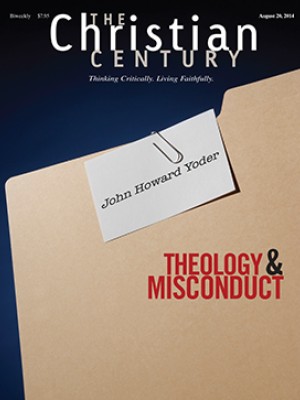Churches seen as failing to welcome people with disabilities
A four-year-old with impaired vision is not allowed in the toddler class in church and is forced to remain in the nursery.
The mother of a child with dwarfing syndrome is told her church cannot provide a stool to allow her daughter to reach the bathroom sink because it would be an insurance risk.
A minister refuses to visit a family’s home because their teen with autism makes him feel uncomfortable.
These stories, reported in a study of more than 400 parents of children with special needs, illustrate how far behind many religious congregations are in understanding and inclusion of people with disabilities.
Just 43 percent of the 416 parents surveyed described their religious community as “supportive,” researchers from the University of Kentucky and Vanderbilt University found.
Almost a third of parents reported having changed their place of worship because their child had not been included or welcomed. More than half kept their sons or daughters from participating in a religious activity because of lack of support.
The lack of inclusion is of special concern because faith communities often help develop supportive social networks in challenging situations. The more frequently children with special needs attended religious services, the higher parents rated their family lives together, sociologist Andrew Whitehead of Clemson University found in analyzing data from the 2011–2012 National Study of Children’s Health. Those positive outcomes included being better able to cope with the day-to-day demands of raising children with special needs.
How can churches, mosques, and synagogues include the faithful who are disabled? Researchers identified seven areas:
1. Communication: Adults with disabilities and parents of children with special needs need to be able to communicate with the congregation about what is required for their participation and how they can work with the community toward full inclusion.
Read our latest issue or browse back issues.
And they need to know that their needs will be heard, Whitehead said. In the survey of parents of children with disabilities, more than half the parents said they had never been asked about the best way to include their daughter or son in religious activities.
2. Accessibility: A basic requirement is that congregations accommodate the physical needs of individuals, by providing handicapped access, amplified audio, or sign language.
In one congregation, a wheelchair-bound child could not attend Sunday school because it was held in an inaccessible area, a mother reported. Church leaders said carrying the youth downstairs was too great a liability risk.
3. Support: Including the disabled in congregational life goes beyond adding a new sound system or a wheelchair ramp.
For example, people with autism or Down syndrome may need an aide or a peer assistant to participate in religious education classes and vacation Bible schools.
Offering worship alternatives such as a shorter service with contemporary music may allow for greater participation for individuals with attention-related issues.
4. Leadership: Faith communities where leaders are committed to including people with disabilities were more welcoming, offered greater opportunities for people with disabilities to share their gifts, and were more physically accessible, according to a primarily web-based survey of 160 respondents conducted by Vanderbilt University researchers.
5. Participation: Inviting people with disabilities to serve on boards and committees and to take visible roles in congregational life—from greeters to readers to worship planners—is an important sign that they are valued members of the community.
Building inclusive communities “is not just about welcoming people with disabilities, but truly including them and respecting what they have to contribute to the community,” said Megan Griffin, lead researcher in the Vanderbilt study, in a recent interview.
6. Education: Congregations that educate their members on disability issues and work together with disability-related organizations are also more welcoming and better able to integrate people with special needs into the life of the community, studies find.
7. Love: The attitudes of fellow congregants may be the most critical factor in whether a religious community is inclusive. In studies, parents of children with special needs who experienced love and acceptance reported their congregations were sources of great strength and support.
In cases where disapproval or censure replaces love, however, the results can be devastating for both people with special needs and their families, the research indicates. Some may abandon their spiritual home or even their faith.
Such disapproval “basically just sends a message you’re not wanted here,” said Whitehead, former director of the U.S. Congregational Life Survey, in a recent interview. “It just makes you feel worthless, that it would be better if you weren’t there.”
The good news is that just about any congregation can serve the disabled. The Vanderbilt study found that factors such as congregation size, the number of people with disabilities, or its location in an urban, suburban, or rural setting did not make a significant difference.
“That’s really an empowering sort of message,” Griffin said. “Ultimately, faith leaders can promote the inclusion of people with disabilities.”
And everyone benefits when congregations embody love and acceptance for all members, several studies have found. As one mother noted, her young-adult daughter with a moderate-to-severe intellectual disability did not have a sophisticated theological grasp of her faith. Yet she “helped the members of that community to have a better understanding of God. . . . She kind of radiates love.” —theARDA.com
Reprinted with permission of the Association of Religion Data Archives






